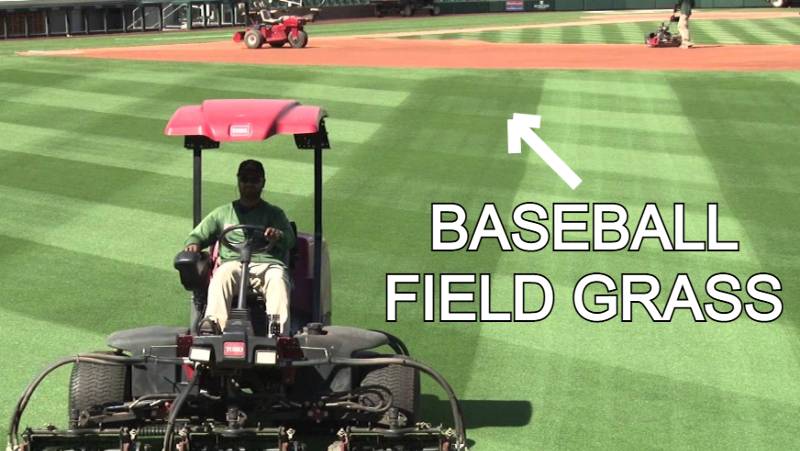Want to learn everything there is to know about baseball field grass?
You’re in the right place.
Last week we spent 34 hours researching MLB Stadiums, the grass used in the ballpark, groundskeeper insights and more.
Read on and you’ll learn:
- The best grass types for baseball fields and the type of grass each MLB Stadium uses
- The MLB stadiums with the best grass and groundskeeper teams (including the best mower they use)
- Tips to achieve the baseball field look in your own yard.
Let’s get started.
Baseball Field Grass – 4 Things You Ought To Know
1. The Pros and Cons of Artificial vs. Natural Grass
As with anything there are pros and cons to both artificial (synthetic) grass and natural grass playing surfaces.
Let’s take a look at them:
Synthetic Grass
- Pros: Less maintenance. Less watering. No mowing required. More durable. Better drainage options. Basically zero operational cost required. Plays consistent no matter the weather conditions.
- Cons: Players prefer natural and believe synthetic causes more injuries and is not as good to play on. The aura and smell of fresh cut and watered grass is what spectators love about going to the game.
- Popular Synthetic Grasses: Shaw Spots B1K and AstroTurf 3D Xtreme are the two types of synthetic grass used in MLB stadiums.
Natural Grass
- Pros: Looks lush and natural. Players prefer it. Spectators prefer it. Is consistent with the history of the game.
- Cons: More maintenance including mowing, watering, fertilizing and as such more money needs to be invested on an operational basis. The grass will wear and tear with use adding to the operational cost.
- Popular Baseball Field Natural Grasses: Kentucky blue grass is the most popular. Then bermuda grass. Then a combination of kentucky blue grass and perennial ryegrass.
Kentucky Bluegrass vs. Bermuda Grass For Baseball Fields
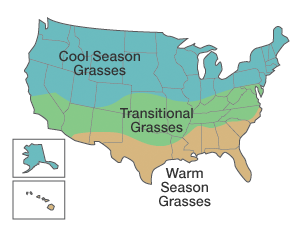 You could write an entire book on this topic comparing grass types. But for the sake of time saving let’s look at the 5 main differences of kentucky bluegrass and bermuda grass:
You could write an entire book on this topic comparing grass types. But for the sake of time saving let’s look at the 5 main differences of kentucky bluegrass and bermuda grass:
- Bermudagrass is best for warm weather MLB stadiums and is more drought tolerant.
- Kentucky bluegrass is best for cool and transitional climate stadiums and is the most popular grass for pro ballparks.
- Bermuda grass is more wear resistant but kentucky bluegrass is better at recovering from damage.
- Kentucky bluegrass requires more maintenance due to its shallow root system.
- Due to the location of many MLB teams kentucky bluegrass is the most hardy grass so will keep green and growing into September and October.
Stadium Baseball Field Drainage
The gist: Sand is good for drainage and clay is bad.
Stadiums will have elaborate drainage systems but the most important factor is sandy soil to allow the fields to drain. All the turf farms optimize for sandy soil and extra wide turf rolls.
2. Dirt vs. Grass Infield
All MLB ballparks have grass infields with dirt only used for the base paths, pitcher’s mound and warning track.
At local baseball fields you will often see all dirt infields and all grass outfields.
Let’s look at the pros and cons of each.
Ball Speed
When the baseball bounces off dirt it maintains its speed better compared to grass due to less friction. In other words: grass slows the baseball down more.
This means it will be hard for players to predict where the ball will bounce off dirt vs. grass – especially if they have grown playing on grass fields.
Tradition
A more important reason for the grass infield is tradition. It looks better as well. Some will balk at the idea of synthetic grass baseball fields for this reason – tradition.
Safety
Grass has more give to it and acts as an extra layer of padding for players sliding to catch a ball. Grass is also not going to get divots over the course of a game players cleats running on it.
3. Best Grass Patterns For Baseball Fields
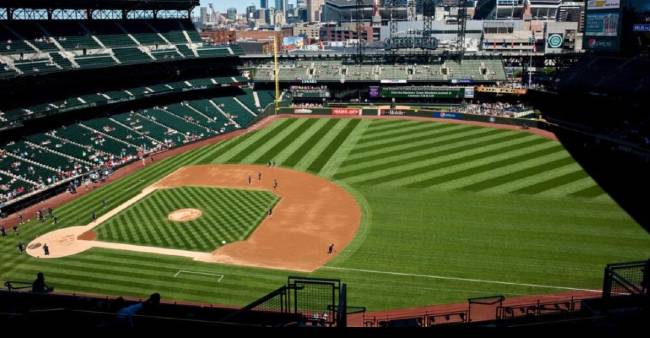
Each ballpark groundskeeper decides which stripes to put on the baseball field.
Which are the best grass patterns is a matter of preference. MLB ballparks will use some form of all stripe styles based on infield or outfield.
How Are The Stripes Made?
Rollers on the mowers are used to push/fold the grass down or up to create the stripe illusion.
The roller pictured is for a push mower but just so you get the idea what we mean by “roller”.

When the light reflects off the grass it appears darker or lighter depending on the direction it has been pushed or folded.
This is the simple way stripes are made on baseball field grass.
Straight Stripes
Straight stripes are common in MLB ballpark outfields.
Checkerboard Stripes
Checkerboard stripes are common in infields.
Curved Stripes
Sometimes groundkeepers will get experimental and go with curved stripes.
Diagonal Stripes
You will sometimes see diagonal stripes in the outfield.
4. Where The MLB Stadium Grass Sod is Grown
4 grass farms provide nearly all the turf for Major League ballparks.
Here’s a little about each:
Graff’s Turf Farms
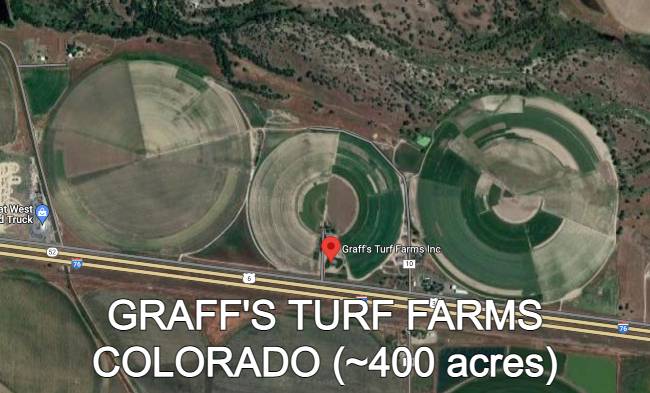
Located northeast of Denver, Colorado, Graff’s Turf Farms is a top 3 provider of high quality natural grass turf for professional sports teams and golf courses.
Their sod is known to be of the highest quality with the best natural drainage properties because of its high sand content.
They work with their clients – like the Minnesota Twins – to produce custom Kentucky Bluegrasses and Fescue for sports fields, golf courses and lawns.
You can check their sod out here.
Tuckahoe Turf Farms
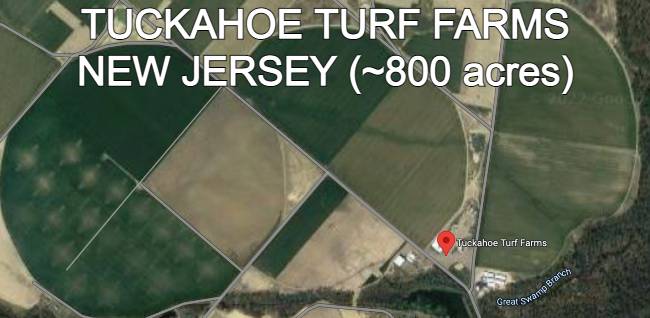
Tuckahoe Turf Farms is located in New Jersey and provides turf to many of the baseball teams located in their area of the USA. This includes the Washington National, the Pittsburgh Pirates, the Boston Red Sox and more.
They provide bluegrass, fescue and bermudagrass turfs. However, all the ballparks use their bluegrass for the baseball fields.
West Coast Turf
West Coast Turf has 5 large turf farms located across California and Arizona. They provide turf for many MLB and NFL teams. They grow high quality bermudagrasses and fescues.
Check their website here.
https://www.westcoastturf.com/Variety-Comparison
How Turf Farms Harvest The Sod Into Rolls
In case you’re interested here is a video showing how they make the sod rolls before trucking them to their customer locations.
What Type of Grass Does Each MLB Stadium Use?
Arizona Diamondbacks – Chase Field
- Grass Type: Shaw Sports B1K Synthetic Grass
The main reason the Diamondbacks use synthetic grass is water savings. They don’t have to water synthetic grass like they would natural grass. And we all know how much water Arizona has – not much. Also, in the hot Arizona summer they close the roof to allow air conditioning and natural grass doesn’t like shade.
Atlanta Braves – Truist Park
- Grass Type: Seashore Paspalum Platinum TE
- Turf Farm: Atlas Turf International
This type of turfgrass will be used at the 2022 FIFA World Cup in Qatar.
Baltimore Orioles – Oriole Park at Camden Yards
- Grass Type: Kentucky Blue Grass
- Turf Farm: Tuckahoe Turf Farms
The Orioles use 100% Kentucky bluegrass and because their owner doesn’t allow concerts (which ruins the grass) they only have to change out the sod every 5 – 8 years. Impressive.
Boston Red Sox – Fenway Park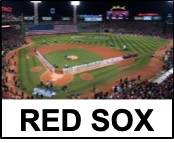
- Grass Type: Kentucky Blue Grass
- Turf Farm: Tuckahoe Turf Farms
100% Kentucky blue grass with high sand content to allow great drainage.
Chicago Cubs – Wrigley Field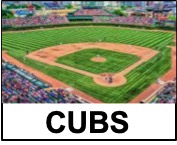
- Grass Type: Kentucky Blue Grass
Chicago White Sox – Guaranteed Rate Field
- Grass Type: Kentucky Blue Grass
Cincinnati Reds – Great American Ball Park
- Grass Type: Perennial Ryegrass
Cleveland Guardians – Progressive Field
- Grass Type: Kentucky Blue Grass
Colorado Rockies – Coors Field
- Grass Type: Kentucky Blue Grass / Perennial Ryegrass
Detroit Tigers – Comerica Park
- Grass Type: Kentucky Blue Grass
Houston Astros – Minute Maid Park
- Grass Type: Platinum TE Paspalum (bahia grass)
- Turf Farm: Atlas Turf International
Kansas City Royals – Kauffman Stadium
- Grass Type: Kentucky Blue Grass / Perennial Ryegrass
LA Angels – Angel Stadium
- Grass Type: Tifway 419 Bermuda Grass
- Turf Farm: West Coast Turf
LA Dodgers – Dodger Stadium
- Grass Type: Santa Ana Bermuda Grass
- Turf Farm: West Coast Turf
Miami Marlins – LoanDepot Park
- Grass Type: Shaw Sports B1K Synthetic Grass
Milwaukee Brewers – American Family Field
- Grass Type: Kentucky Blue Grass
Minnesota Twins – Target Field
- Grass Type: Kentucky Blue Grass
- Turf Farm: Graff’s Turf Farms
New York Mets – Citi Field
- Grass Type: Kentucky Blue Grass
New York Yankees – Yankee Stadium
- Grass Type: Kentucky Blue Grass
Oakland Athletics – Oakland Coliseum
- Grass Type: Tifway II Bermuda Grass
- Turf Farm: West Coast Turf
Philadelphia Phillies – Citizens Bank Park
- Grass Type: Kentucky Blue Grass
Pittsburgh Pirates – PNC Park
- Grass Type: Kentucky Blue Grass
San Diego Padres – Petco Park
- Grass Type: BullsEye Bermuda Grass
San Francisco Giants – Oracle Park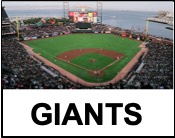
- Grass Type: Tifway 419 Bermuda Grass
- Turf Farm: West Coast Turf
Seattle Mariners – T-Mobile Park
- Grass Type: Kentucky Blue Grass / Perennial Ryegrass blend
St. Louis Cardinals – Busch Stadium
- Grass Type: Kentucky Blue Grass
- Turf Farm: Graff’s Turf Farms
Tampa Bay Rays – Tropicana Field
- Grass Type: Shaw Sports B1K Synthetic Grass
Texas Rangers – Globe Life Field
- Grass Type: Shaw Sports B1K Synthetic Grass
Toronto Blue Jays – Rogers Centre
- Grass Type: AstroTurf 3D Xtreme
Washington Nationals – Nationals Park
- Grass Type: Kentucky Blue Grass
Tier List: Ranking MLB Ballpark Grass
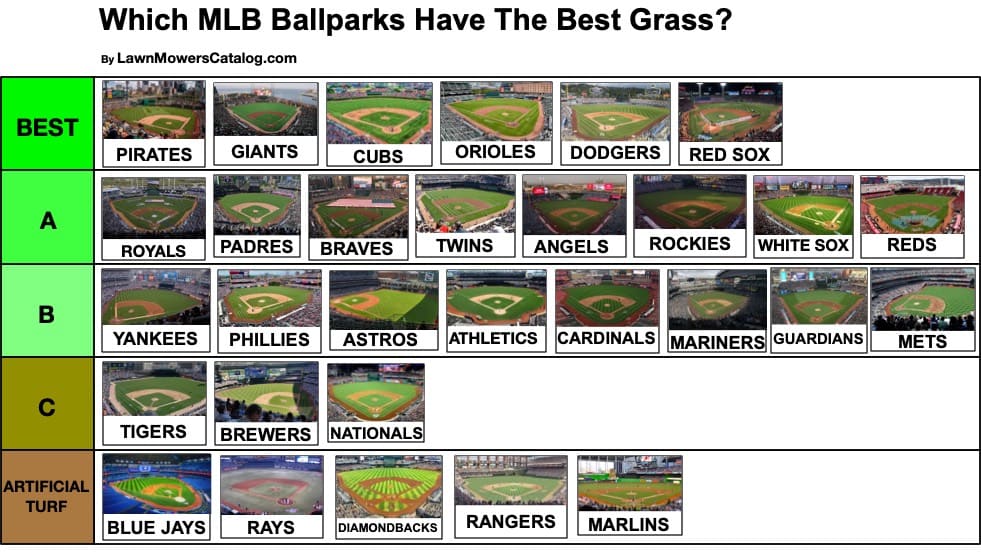
Field vs Park vs Stadium vs Coliseum – Naming Conventions of MLB Ballparks Explained
The gist: There is no difference between these words when it comes to a baseball field.
The owners decide what they want the building to be called for branding or marketing purposes.
For example: Fenway Park sounds small and intimate whereas Yankee Stadium sounds big and epic. At the end of the day they are all stadiums with room for tens of thousands to come and watch baseball.
Wrap Up
Baseball field grass at the Major League level is grown and maintained by professionals with many years experience. They have big budgets and access the best mowers, fertilizers, soil test kits and irrigation methods. The two most popular grasses for baseball fields is kentucky bluegrass and bermudagrass.
Sources:
- Target Field to get first batch of grass tonight. MPRNews.org. Info retrieved Sept. 7, 2022
- Major League Turf – The Grass Used at Each Ballpark. BaseballPilgrimages.com. Info retrieved Sept. 7, 2022.
- WCT Clients–Current and *Past. WestCoastTurf.com. Info retrieved Sept. 7, 2022.
- https://www.thefreelibrary.com/Grass+is+greener+for+company+with+major+league+clout%3A+Graff%27s+Turf…-a0259382068

